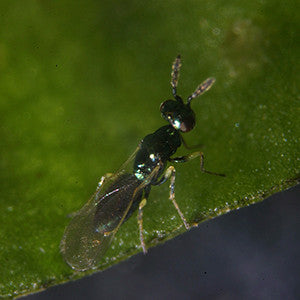-
Diglyphus isaea is a widespread parasitoid of leafminer larvae. It is reported from a large number of host species, but commercially is of interest as a parasite of Liriomyza bryoniae, L. trifolii and L. huidobrensis, as well as of the Chrysanthemum Leafminer Phytomyza syngenesiae.
The adult wasps are very variable in size, and are a dark metallic green in colour. They search for host larvae of suitable size within leaf tissue, and sting them through the leaf cuticle. The sting paralyses the host larva within a short time, and the female wasp then lays one or more eggs alongside it. The hatching Diglyphus larvae feed externally on the paralysed, but still living, host. It is described as an ectoparasitoid. Parasitised larvae can be recognised by the lack of movement within the mine: they will often move away from the end of the mine, where a healthy larva would be actively feeding. Microscopic examination and dissection of the mine will show them to be flaccid and unresponsive. The host larva will discolour as the parasite develops, and because it is no longer feeding, the mine stops growing.
- 0.25-0.5 predators per 10 square feet. Two back-to-back introductions over 2 weeks is recommended.
- Hold the bottle horizontally and remove the lid. Release the parasites by gently tapping the opened bottle while walking through the crop. Leave the open bottle upright in the infested area for a few hours to allow any remaining parasites to escape. In hot sunny weather, release early or late in the day. Do not cold store adults for more than 18 hours, holding in darkness at 55-60.
- Orders for D. isaea must be received by noon on Thursday for shipment the following Wednesday, with exceptions for major holidays. Beneficial insects are normally shipped by FedEx Ground within the state of Washington, and by FedEx Express elsewhere in the USA. Please contact us directly if you require a different method of shipping.

